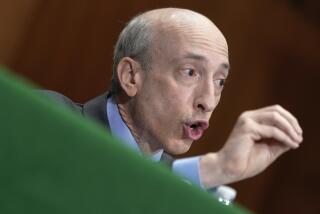NYSE Trading May Get Electronic Jolt
- Share via
NEW YORK — The New York Stock Exchange is poised to leap into the future.
The board of directors is expected to consider today a proposal to increase the amount of stock trading done by computers. It would be a dramatic shift for the 211-year-old exchange.
Big Board officials have long contended that the current system, in which a knot of traders huddle on the famed trading floor to do most of the actual buying and selling of shares, is far superior to an automated, Nasdaq-style market.
But the NYSE is facing pressure from nimble electronic competitors and the increasing irritation of mutual funds and other big investors that think the business of trading at the exchange is antiquated.
Today’s vote “is a recognition on the NYSE’s part that electronic trading is here to stay and you better be part of it or step aside,” said Rob Hegarty of TowerGroup, a financial technology consulting firm.
The proposal is the first initiative of John Thain, who became the NYSE’s chief executive last month after Richard Grasso was ousted in a flap over his compensation. Thain’s swift pursuit of a decision on electronic trading signals that this could be the first step in transformation of the way U.S. stocks are traded.
“This is huge if it happens,” said John Wheeler, head of stock trading at American Century mutual funds, calling it a “sea change.”
Experts generally praised Thain’s strategy, saying a failure to modernize would hurt the Big Board.
“It’s his only move. He doesn’t have that many options,” said Larry Tabb, a financial technology consultant in Westboro, Mass.
For small investors, increased electronic trading wouldn’t mean much, experts said, though it would significantly help the mutual funds trading on their behalf.
The primary benefits would be faster trade executions and a better chance of having trades effected at desired prices.
Electronic trading also could prevent some of the abuses that critics complain are routine on the exchange floor. (The NYSE and the Securities and Exchange Commission are investigating potentially improper trading by some NYSE “specialist” firms.)
In some ways, the push to automate is tied to Grasso’s absence.
Grasso aggressively defended the NYSE’s human-based system, using his once-celebrated public persona to bash electronic rivals. But the controversy over his outsize compensation package sparked a reassessment of all aspects of the NYSE and made critics and regulators more willing to challenge it.
“Grasso did a very good job of keeping the current NYSE trading process and practices intact for as long as he could,” Hegarty said.
“What we’re going to see is Thain [pursuing] a strategy of the NYSE embracing electronic trading rather than holding it off.”
Thain’s plan would lift some of the impediments that have limited the use of the exchange’s inchoate electronic system known as Direct Plus. It would abolish a limit of 1,099 shares per trade, which has kept institutions from executing large blocks. It also would scrap a 30-second delay between trades.
Direct Plus accounts for less than 6% of NYSE volume. About 75% of NYSE volume would be eligible for Direct Plus if the changes are made, according to NYSE statistics.
An NYSE spokesman declined to comment. The exchange has scheduled a news conference for 5 p.m. today.
The specter of increased electronic trading has stirred fears among the NYSE’s so-called specialists and floor brokers who worry about possible job losses.
“The specialists are mixed, and the brokers are extremely concerned,” said Samuel Lek, founder and chief executive of Lek Securities in New York, which owns four NYSE seats. “They are very concerned that a lot of the trades will be done electronically now.”
Experts aren’t sure how the plan would affect the NYSE and jobs there, in part because few details have been released.
Some say electronic trading would spark a major realignment in which heavy demand for computerized trades would reduce the need for human traders and, eventually, for the NYSE’s vast trading floor.
Others say the move could strengthen the NYSE: Small, easily filled orders could be done electronically, and people on the floor could focus on complicated orders, such as assembling large blocks of thinly traded shares.
At the NYSE, said Ken Polcari, managing director of a floor brokerage, “there’s plenty of room” for both people and computers.
More to Read
Inside the business of entertainment
The Wide Shot brings you news, analysis and insights on everything from streaming wars to production — and what it all means for the future.
You may occasionally receive promotional content from the Los Angeles Times.










